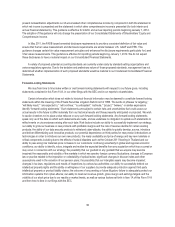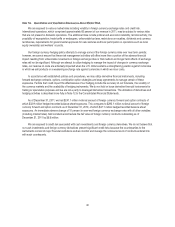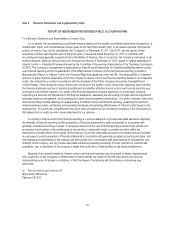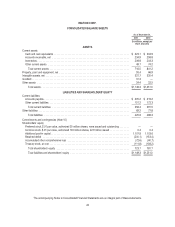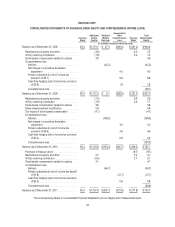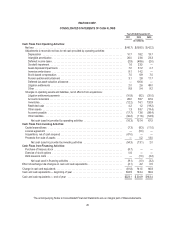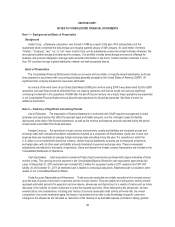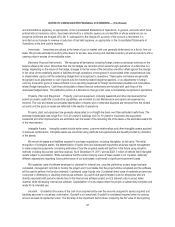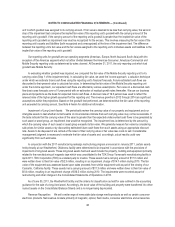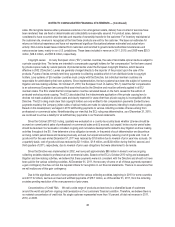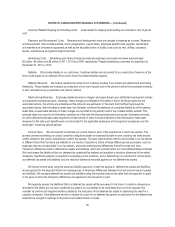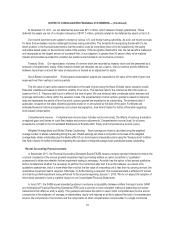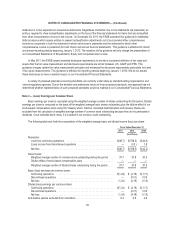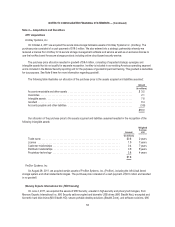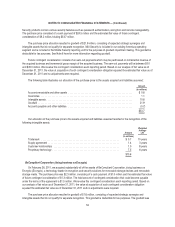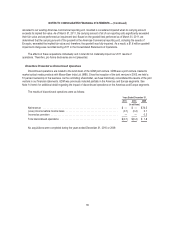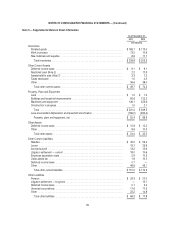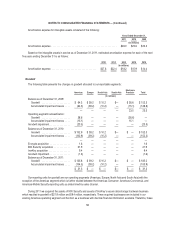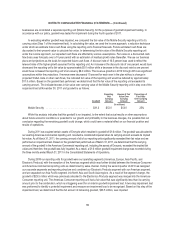Memorex 2011 Annual Report Download - page 52
Download and view the complete annual report
Please find page 52 of the 2011 Memorex annual report below. You can navigate through the pages in the report by either clicking on the pages listed below, or by using the keyword search tool below to find specific information within the annual report.NOTES TO CONSOLIDATED FINANCIAL STATEMENTS — (Continued)
sales. We recognize revenue when persuasive evidence of an arrangement exists, delivery has occurred or services have
been rendered, fees are fixed or determinable and collectability is reasonably assured. For product sales, delivery is
considered to have occurred when the risks and rewards of ownership transfer to the customer. For inventory maintained at
the customer site, revenue is recognized at the time these products are sold by the customer. We base our estimates for
returns on historical experience and have not experienced significant fluctuations between estimated and actual return
activity. Non-income based taxes collected from customers and remitted to governmental authorities include levies and
various excise taxes, mainly in non U.S. jurisdictions. These taxes included in revenue in 2011, 2010, and 2009 were $20.3
million, $28.3 million, and $50.9 million, respectively.
Copyright Levies. In many European Union (“EU”) member countries, the sale of recordable optical media is subject to
a private copyright levy. The levies are intended to compensate copyright holders for “fair compensation” for the harm caused
by private copies made by natural persons of protected works under the European Copyright Directive, which became
effective in 2002 (“Directive”). Levies are generally charged directly to the importer of the product upon the sale of the
products. Payers of levies normally remit levy payments to collecting societies which in turn distribute funds to copyright
holders. Levy systems of EU member countries must comply with the Directive, but individual member countries are
responsible for administering their own systems. Since implementation, the levy systems have been the subject of numerous
litigation and law making activities. On October 21, 2010, the European Court of Justice (“ECJ”) ruled that fair compensation
is an autonomous European law concept that was introduced by the Directive and must be uniformly applied in all EU
member states. The ECJ stated that fair compensation must be calculated based on the harm caused to the authors of
protected works by private copying. The ECJ also stated that the indiscriminate application of the private copying levy to
devices not made available to private users and clearly reserved for uses other than private copying is incompatible with the
Directive. The ECJ ruling made clear that copyright holders are only entitled to fair compensation payments (funded by levy
payments made by the Company) when sales of optical media are made to natural persons intending to make private copies.
Based on this development, we began in 2010 withholding payments to various collecting societies of levies arising from
professional or commercial sales. Notwithstanding our view that the ECJ ruling was determinative, as of December 31, 2010,
we continued to accrue a liability for all withheld levy payments in our financial statements.
Since the October 2010 ECJ ruling, quarterly we evaluated on a country-by-country basis whether (i) levies should be
accrued on current period sales of professional or commercial sales and (ii) accrued, but unpaid, levies on prior period sales
should be reversed. Our evaluation considers ongoing and cumulative developments related to levy litigation and law making
activities throughout the EU. If we determine a levy obligation is remote, in the period of such determination we discontinue
accruing current period levies and reverse previously accrued, but unpaid amounts by reducing cost of goods sold. Cost of
goods sold for the year ended December 31, 2011 was reduced by $7.8 million due to reversal of prior year levy accruals. On
a quarterly basis, cost of goods sold was reduced by $2.1 million, $1.9 million, and $3.8 million during the first, second, and
third quarters of 2011, respectively, due to reversal of prior year obligations that were determined to be remote.
Since the Directive was implemented in 2002, we have paid approximately $85 million in levies to various ongoing
collecting societies related to professional and commercial sales. Based on the ECJ’s October 2010 ruling and subsequent
litigation and law making activities, we believe that these payments were not consistent with the Directive and should not have
been paid to the various collecting societies. At December 31, 2011, the recovery of some or all of these payments represent
a gain contingency that has not met the required criteria for recognition in our financial statements. There is no assurance that
we will realize any of this gain contingency.
Due to this significant amount of over payments to the various collecting societies, beginning in 2010 for some countries
and 2011 for others, we have accrued and withheld payments of $19.7 million, as of December 31, 2011, from the collecting
societies pending resolution of the over payments of prior years.
Concentrations of Credit Risk. We sell a wide range of products and services to a diversified base of customers
around the world and perform ongoing credit evaluations of our customers’ financial condition. Therefore, we believe there is
no material concentration of credit risk. No single customer represented more than 10 percent of total net revenue in 2011,
2010, or 2009.
49


